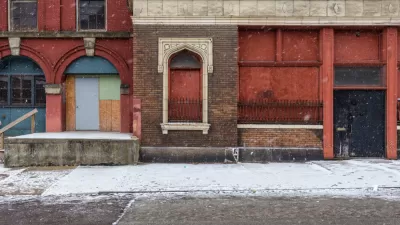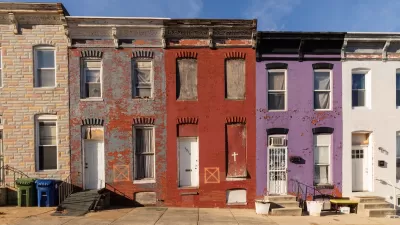As the city of Baltimore grapples with a declining population, it faces obstinate challenges in controlling the problems associated with vacant buildings, including the "vicious cycle" of vacancies causing more vacancies.

"Despite demolition crews working at an unprecedented pace in recent months to tear down Baltimore’s vacant houses, the number of abandoned buildings in the city has barely budged," reports Ian Duncan and Christine Zhang.
"Even as long rows of empty houses are being razed, other homes are going vacant much faster than officials had expected — for reasons they’re at a loss to explain."
In February, the city counted 16,724 vacant buildings in the city. Eight months later, the city counted 16,577. The city had hoped to bring that number below 15,000 by the beginning of 2020, but now it appears that goal is out of reach.
According to city data, the number of vacant buildings in neighborhoods targeted by the city demolition program has dropped, but increasing numbers of vacant buildings in other neighborhoods have kept the overall figures stagnant.
The article includes a description of the "vicious cycle" caused by vacant buildings begetting more vacant buildings, the negative effects of that cycle, and a more granular analysis of neighborhood-level demolitions and vacancies.
FULL STORY: Baltimore is furiously knocking down vacant houses — but barely keeps up as new ones go empty

Alabama: Trump Terminates Settlements for Black Communities Harmed By Raw Sewage
Trump deemed the landmark civil rights agreement “illegal DEI and environmental justice policy.”

Planetizen Federal Action Tracker
A weekly monitor of how Trump’s orders and actions are impacting planners and planning in America.

Why Should We Subsidize Public Transportation?
Many public transit agencies face financial stress due to rising costs, declining fare revenue, and declining subsidies. Transit advocates must provide a strong business case for increasing public transit funding.

How Housing as a Financial Product Harms Communities
Institutional buyers who treat housing as an investment product become disconnected from the impacts of higher rents, displacement, and housing instability.

Blinded by the Light: When Brighter Headlights Decrease Safety
Bright LED headlights can create glare and reduce visibility for other drivers and pedestrians.

Study Links Covid and Poor Driving
The effects of the virus, including ‘brain fog,’ can make driving more difficult and dangerous.
Urban Design for Planners 1: Software Tools
This six-course series explores essential urban design concepts using open source software and equips planners with the tools they need to participate fully in the urban design process.
Planning for Universal Design
Learn the tools for implementing Universal Design in planning regulations.
Caltrans
Smith Gee Studio
Institute for Housing and Urban Development Studies (IHS)
City of Grandview
Harvard GSD Executive Education
Toledo-Lucas County Plan Commissions
Salt Lake City
NYU Wagner Graduate School of Public Service




























